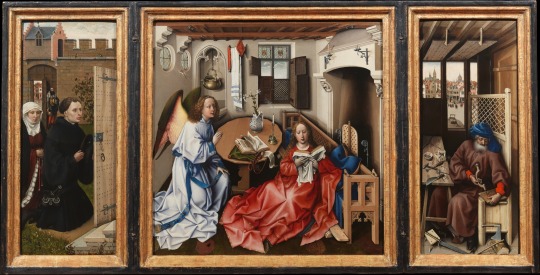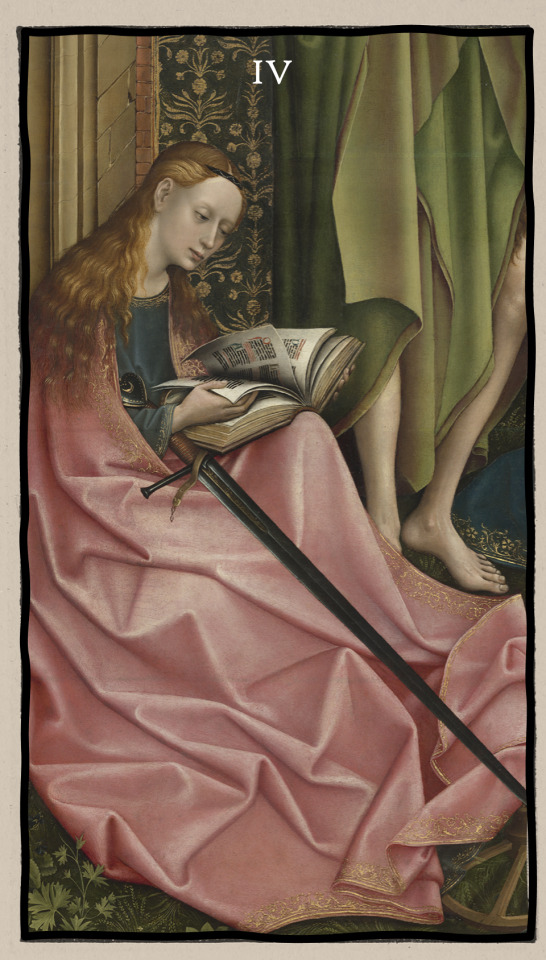#robert campin
Explore tagged Tumblr posts
Text

Robert Campin
52 notes
·
View notes
Text

Robert Campin, workshop (Netherlandish/French, c.1373-1444) Annunciation Triptych (Merode Altarpiece), ca.1427-32 The Cloisters Museum and Gardens, New York The kneeling donor appears to witness the central scene through the open door. His wife kneels behind him, and a town messenger stands at the garden gate. The owners would have purchased the triptych to use in private prayer.
#Robert Campin#Netherlandish#Netherlands#Netherlandish art#Flemish#Flemish art#Flanders#French#French art#France#Annunciation triptych#merode altarpiece#1400s#medieval#renaissance#art#fine art#european art#classical art#europe#european#fine arts#oil painting#europa#mediterranean#christian art#christian#christianity#christentum#catholic
126 notes
·
View notes
Text

Nativity, 1420 by Robert Campin
4 notes
·
View notes
Text

granstromjulius
Robert Campin
10 notes
·
View notes
Text

Entre a espada e a parede
"João Carneiro estava com a pupila desvairada, a pálpebra trêmula, o peito ofegante. Os olhares que deitava a Sinhá Rita eram de súplica, mesclados de um tênue raio de censura. Por que lhe não pedia outra cousa?"
Machado de Assis, "O Caso da Vara"; pintura atribuída a Robert Campin.
12 notes
·
View notes
Text

Robert Campin, The Merode Altarpiece, ca. 1427-1432, oil/panel (Met Museum, NYC)
24 notes
·
View notes
Photo

The Madonna of Humility, after Robert Campin, circa 1450–1470
Oil on panel 48.6 x 37.8 cm (19 ⅛ x 14 ⅞ in.) J. Paul Getty Museum, Los Angeles, CA, USA
#art#painting#robert campin#renaissance#northern renaissance#15th century#1450s#1460s#religious#the getty#netherlandish#dutch#oil
30 notes
·
View notes
Photo

Holy Virgin in Glory by Robert Campin - 1430
8 notes
·
View notes
Text

A mousetrap and tools appear before Joseph in Robert Campin's Merode Altarpiece, which depicts the angel telling Mary she is pregnant with Jesus. These tools seem like a logical addition, given the fact that Joseph was a carpenter by trade, but they have a deeper meaning. When this Netherlandish masterpiece was completed during the 1420s, people often called Joseph a mousetrap for the devil. This refers to the fact that he was Mary's cover story. The devil would assume Jesus was Joe's son and leave the kid alone. I see what you did there, Campin.
Complete image:

Annunciation Triptych (Merode Altarpiece) Robert Campin and workshop c. 1428 In the collection of The Met Cloisters, New York City, USA
#robert campin#painting#altarpiece#art#artwork#art history#northern renaissance#netherlandish art#Campin#Merode altarpiece#Annunciation triptych#Annunciation#Mary#angel#Joseph#mousetrap#mouse#tools
2 notes
·
View notes
Text

Triptyque de la mise au tombeau - Robert Campin. 1410 - Paint and gilding on wood
#this one isnt in my personal taste but i couldnt deny that the capacity for details mixed with the plain caught my eye#robert campin#art#christian art
0 notes
Text

Robert Campin
#robert campin#annunciation#angel#art#artwork#fine art#fineart#painting#art history#history of art#women in art
26 notes
·
View notes
Photo

Jan van Eyck
Jan van Eyck (c. 1390-1441 CE) was a Netherlandish Renaissance painter who was famous in his own lifetime for his mastery of oil painting, colouring, naturalistic scenes, and eye for detail. Amongst his masterpieces are the 1432 CE Ghent Altarpiece, otherwise known as The Adoration of the Mystic Lamb, and the Arnolfini Wedding Portrait, a tour de force in optical illusions. A pioneer of using oils for realistic effects, his work was influential on Renaissance art but especially on Italian artists in the second half of the 15th century CE.
Early Influences & Style
Jan van Eyck was likely born in Maaseik, Belgium c. 1390 CE. His family was aristocratic and he may have had an elder brother, Hubert van Eyck (d. 1426 CE), although this figure remains a highly mysterious one in the world of art (see below on the Ghent Altarpiece). Jan van Eyck was first active in art in 1422 CE when he worked for the Bishop of Liège. However, none of Jan's early works can be definitely attributed to him. Works are usually associated with his hand because of a belief (by no means certainly attested either) that he worked as an illuminator of manuscripts as a young man. It is for these stylistic reasons that Jan van Eyck (and/or his brother Hubert) are frequently identified as the creators of the miniatures within the illuminated manuscript known as the Turin-Milan Book of Hours.
Another early influence was the work of Robert Campin (c. 1378-1444 CE) who was active in Tournai, Belgium. The realism and luminosity in van Eyck's work may well have been inspired by Campin's paintings, even if van Eyck overshadowed him during the Renaissance period and beyond. Van Eyck's later works are more securely identifiable and are often signed or carry the inscription: 'Johannes de Eyck'. An additional mark of authorship was the artist's family motto: 'As best I can' or 'As I am able' (Als ik kan or Als Ich Can), perhaps also a pun on his own name. It is in his later works that we can best see his definite and quite unique style of painting.
In the 15th century CE tempera remained the most popular medium for paintings, but Jan van Eyck would master the technique of oil painting, one of the first Renaissance artists to do so, even if it was not a new medium. Oils allowed for greater subtlety in colours and tone, and they permitted the achievement of real depth in a painting that tempera panels or frescoed walls could not match. Consequently, van Eyck's work is typified by its high degree of naturalistic detail, achieved using the very finest of brushes. Everything in his paintings, from the skin of a face to the distant hills seen through a background window, is rendered in minute and utterly convincing detail. Other Eyckian features are the brilliant colours, rich texture and overall finish. Yet another feature of the artist's work is his frequent use of everyday objects in scenes to obliquely signify religious ideas. A shell, for example, signified the resurrection of Jesus Christ while Gothic architecture symbolised the New Covenant.
Continue reading...
28 notes
·
View notes
Text
Robert Campin (c.1375-1444)
Annunciation, 1420s.
Royal Museums of Fine Arts of Belgium

2 notes
·
View notes
Text
Oh, I'm a good old rebel,
Now thats just what I am,
And for this yankee nation,
I do no give a damn.
I'm glad I fought a ganner,
I only wish we won.
I aint asked any pardon for anything I've done.
I hates the yankee nation and eveything they do.
I hates the declaration of independence, too.
I hates the glorious union, just dripping with our blood.
I hates the striped banner, and fitted all I could
I road with Robert E. Lee,
For three years, thereabout.
Got wounded in four places,
And I starved at point lookout.
I caught the Romatism
Campin' in the snow.
But I killed a chance of Yankees
And I'd like to kill some more.
3 hundred thousand Yankees
Is stiff in southern dust.
We got 3 hundred thousand
Before they conquered us
They died of Southern Fever
And southern steel and shot
I wish there were 3 million
Instead of what we got.
I can't pick up my musket
And fight 'um down no more
But I ain't gonna love 'um
Now that is certain sure
And I don't want no pardon
For what I was and am
I won't be reconstruted
And I do not give a damn
Oh, I'm a good old rebel,
Now thats just what I am,
And for this yankee nation,
I do no give a damn.
I'm glad I fought a ganner,
I only wish we won.
I aint asked any pardon for anything I've done.
I aint asked any pardon for anything I've done.
I see this from the perspective of a Southerner who knew and believed in the opening lines of the Declaration of Independence, yet saw his foe denying those rights to the South. A Southerner coming to the realization that the constitution was only a paper document that could not stop a tyrant.
9 notes
·
View notes
Text
charlotte's art history tarot - four of swords

Art: Madonna and Child with Saints in the Enclosed Garden – Follower of Robert Campin
pull this card
info on the suit of swords in general
after the sudden sorrow of the three, the four of of swords is a card of withdrawal. this card encourages us to cast our focus inwards and find out what we need to do for ourselves to begin the process of recovery. the four welcomes us to rest and gather our strength for whatever may lay ahead
#charlotte's art history tarot#tarot#tarot cards#tarot deck#swords#suit of swords#tarot swords#swords tarot#four of swords#saint catherine#swords in art#women with swords#art#art history
10 notes
·
View notes
